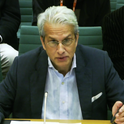Tim Geithner: One of his allies in Congress, Barney Frank, once told him that when he spoke in public, “he looked like he was at his own bar mitzvah.”
Public officials write memoirs for two reasons: to make money or to set the record straight. If there’s one thing that former US Treasury Secretary Tim Geithner would like readers of his new book, Stress Test, to know, it’s that his decision to plough hundreds of billions of taxpayer dollars into banks during the financial crisis was never about the money—and it was never just about the banks. His “only priorities,” he insists, were limiting the damage to ordinary Americans and to the broader global economy.
He first makes the point on page two and he’s still making it 527 pages later. I worked closely with Geithner during the 1990s at the US Treasury and I have no doubt he believes what he says is true. I also know that he has never worked for any bank. Unfortunately for him, I’m in the minority on both points.
It’s one of the running gags of Stress Test that most people think Geithner used to be a banker. Again and again, senior journalists, politicians and critics refer to his “previous career” at Goldman Sachs, despite continued efforts to set them straight.
He quotes one typical exchange, in early 2009, with a critical member of the Congressional Oversight Panel examining the administration’s plan for buying “toxic” bank assets: “‘Let me stop you right there,’ [Damon] Silvers said. ‘What I don’t get—and I practise law, and you’ve been in banking—is a deal—’
‘I’ve never actually been in banking,’ I interrupted.
‘Well, a long time ago,’ he said.
‘Actually, never,’ I replied.
‘Investment banking,’ Silvers retorted.
‘Never investment banking,’ I said...
‘Alright,’ Silvers conceded. ‘Very well then.’ And then he continued his attack on the Public-Private Investment Program as a shocking handout to financial interests.”
With so many ex-Goldman types in Washington—Geithner’s predecessor at the Treasury was a former Goldman CEO—the mistake is perhaps understandable. But lesson one of Stress Test is that Tim Geithner is not and never has been a banker. Some will say he is now making up for lost time, having taken a job for a leading private equity firm. But to me, that’s a bit different.
Another lesson, which comes through in nearly every page, is that he is a dedicated and profoundly normal kind of guy who has worked for a long time on the financial front line, at some personal cost to him and his family. When public outrage at the financial rescues was at its height in 2009, Barack Obama told a Washington dinner that he needed to house-train his dog, Bo, “because the last thing Tim Geithner needs is someone else treating him like a fire hydrant.”
I have encountered some highly effective managers and some very likeable, low key ones in my career in government, journalism and now banking. But Tim is the only person I have encountered in a job with any responsibility who managed to be both—and self deprecating, to boot.
Recalling his first major speech as Treasury Secretary, he writes: “I swayed back and forth, like an unhappy passenger on an unsteady ship. I kept peering around the tele-prompter to look directly at the audience, which apparently made me look shifty; one commentator said I looked like a shoplifter. My voice wavered. I tried to sound forceful, but I just sounded like someone trying to sound forceful.” By the time he had finished speaking the US stock market had fallen by more than 3 per cent. It was down around 5 per cent on the day.
When Geithner and I worked together he was still a mid-level official, though rising fast. Witnessing the quiet, unassuming way that he made everyone in his office want to do their very best for him, I found myself thinking he could have been president, if he had only been a bit bigger. He’s just under 5 foot 9, with what journalists tend to describe as a “boyish” physique.
The lack of gravitas and grey hairs were handicaps when he took over as Treasury Secretary in the heat of the financial crisis in early 2009. One of his allies in Congress, Barney Frank, later told him that when he spoke in public, “I looked like I was at my own bar mitzvah.” As it happens, Geithner isn’t Jewish either, though it’s another common misperception. When he met Barbara Streisand at a state dinner, she told him that “I must be alright because I was a Brooklyn Jew; which was kind of her, except that I’m not Jewish and I’ve never lived in Brooklyn.”
Geithner really knows a lot about financial crises, having seen at close hand all of the major financial fires of the last 20 years, starting with the Mexican “Tequila” crisis of 1994. As former Bank of England Governor Mervyn King has joked, “Tim has been present at all the crises. But he did not cause the crises. The crises caused Tim.” He’s a grown-up about how to handle them, unlike many of the European officials he had to deal with when the eurozone was blowing up. Many of them do not come out of the book very well.
The book is a little long, and it’s rather defensive. But when they finish it, most people will probably accept that Geithner is a decent, hard-working person who did what he thought was best. They might even accept that he was never a banker. But having the right motive is not quite the same thing as actually being right. Rather often, he seems to equate the two.
When financial crises happen, governments have to do unpopular things. “What feels just and fair is often the opposite of what’s required for a just and fair outcome,” Geithner acknowledges. But in the account he gives, we don’t see him thinking a lot about what will deliver a “just and fair outcome.” In the throes of battle, there simply isn’t time. Instead we see him deliberating over what will work to restore confidence and growth.
Geithner believes that it would have been worse for everyone, in the long run, if the shareholders and creditors of the major banks had been made to pay a higher price—and bondholders in rescued institutions had been forced to take “haircuts” (mandatory write-downs). He thought that this kind of “Old Testament justice” would only worsen the crisis and, in the autumn of 2008, he was probably right.
But he didn’t want to force banks to conserve capital and cut dividends in the run up to the crisis, either—despite mounting evidence that they were not going to have enough to weather the storm. Nor, in March 2009, did he prevent AIG from paying out $165m in bonuses to employees in the Financial Products Unit that had helped blow up the firm. AIG was then the recipient of well over $100bn in emergency public funds, but Geithner thought “the public relations of trying to intervene would pale in comparison to the damaging spectre of the US government trying to break a private contract.”
Geithner might have been right in all of these judgements. We will simply never know. But we do know there were plenty of people inside and outside the administration—including his (and my) former boss, Larry Summers—who didn’t think the cost of restoring confidence needed to be quite so hard to swallow. Even if history ends up taking Geithner’s side, I suspect it will hesitate to suggest the outcome was “just and fair.”
Right or wrong, Geithner will surely go down as the “man who bailed out Wall Street.” At all the key moments during the crisis, he hoped and believed that what would be good for confidence in banks would be good for everyone else. Maybe there was a “fairer” way to do that. But responding to financial crises is about choosing between bad options. Herbert Hoover went down in history as the man who failed to bail out Wall Street, and so failed to halt the slide into the Great Depression. I know which one I’d rather be, and Geithner is pretty sure too.












